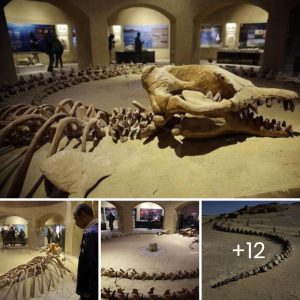Thanks to hundreds of bones unearthed by palaeontologists in the fossil graveyards of Alberta, Canada, a showy new member has joined the family of horned dinosaurs that includes the iconic herbivore Triceratops. What’s more, the fossil find is helping researchers unlock some of the secrets of dinosaur horn evolution.
The group Triceratops and its cousins belong to – the ceratopsians – is striking at first glance. Usually adorned with spikes and other bizarre ornaments, the dinosaurs also displayed elongated frills formed by the extension of bones making up the top of the skull. They also had beaks for stripping low-lying plants before slicing them up with “batteries” of toughened teeth.
Since its cameo appearance in Jurassic Park, Triceratops has been the family’s most famous representative, easily recognisable by the three horns on its face and a large, flashy head-frill. Even the name (not the most original palaeontologists have ever come up with) is Latin for “three-horned face”.
A student digs up bones at the Wendiceratops bonebed quarry. Image: David Evans
But the newly discovered dinosaur puts Triceratops’ head armour to shame. The find was made by researchers from the Royal Ontario Museum (ROM), who uncovered more than 200 bones belonging to the new species, the fossil remains of a small herd of three adults and one younger dinosaur. The findings are published in the journal PLOS ONE.
Named Wendiceratops (meaning “Wendy’s horned-face”, after renowned Alberta fossil hunter Wendy Sloboda), the new species (Wendiceratops pinhornensis) was clearly a trendsetter. “The wide frill of Wendiceratops is ringed by numerous curled horns, the nose had a large, upright horn, and it’s likely there were horns over the eyes too. The number of gnarly frill projections and horns makes it one of the most striking horned dinosaurs ever found,” says co-author of the study, Dr David Evans.
Early estimates place Wendiceratops right in the heavyweight category, at around six metres (20ft) in length and weighing in at more than a tonne. It would have roamed the earth around 79 million years ago, making it one of the oldest members of its horned family.
These unique attributes make Wendiceratops an especially exciting find for palaeontologists who want to learn more about why elaborate horns and frills evolved in this dinosaur group in the first place. “Wendiceratops helps us understand the early evolution of skull ornamentation in an iconic group of dinosaurs characterised by their horned faces,” says Evans.
Life reconstruction of Wendiceratops pinhornensis. Image: Danielle Dufault.
Susie Maidment, a dinosaur expert and researcher at Imperial College London, suggests that having an array of distinguishing features would have come in handy when it came to recognising your own kind. “Wendiceratops seems to have been living alongside at least three other [similar] species … and it may be that [skull] ornamentation was a key aspect in species recognition. If you are going to be living in an environment where there were lots of other similar-looking animals, it’s pretty important to make sure you’re mating with the right [one].”
ROM researcher Thomas Cullen, who wasn’t directly involved in the study (though he’s hunted for fossils at the Wendiceratops site before), agrees. He adds: “If I had to speculate, I’d say that the frill ornamentation was likely used for species recognition or display, though the latter explanation is difficult to prove.”
Aside from the strange curved horns decorating its frill, Wendiceratops had another interesting and distinctive attribute: a large, upright-pointing horn, known as a horncore, on its nose. The presence of this horn is the earliest documented occurrence of this feature in any specimen in this dinosaur group – an important clue for scientists about when these unique horns originated.
“The locked horns of two Wendiceratops could have been used in combat between males to gain access to territory or females,” speculates Dr Michael Ryan, curator of Vertebrate Palaeontology at the Cleveland Museum of Natural History and co-author of the study. This would suggest that even the earliest horned dinosaurs might have displayed such duelling behaviour.
These new findings come just weeks after another research group from the Royal Tyrell Museum of Canada discovered their own new species – Regaliceratops, named for its peculiar frill display. Although that study was perhaps more notable for the marriage proposal lurking in the acknowledgements section, it does show that despite the fact that we’ve known about ceratopsian dinosaurs for many years, new findings are still helping us answer questions about their evolution that we never thought were possible.
The Wendiceratops discovery is the latest in a series by Evans and Ryan, forming part of their Southern Alberta Dinosaur Project, a mission to increase our understanding of the last days (well, the last millions of years) of dinosaur evolution in Alberta and Montana. The skeleton of Wendiceratops will be on display at the Royal Ontario Museum in Toronto, and you can find out more about it on Twitter by following @ROMToronto or following the hashtag #ROMDinos.







